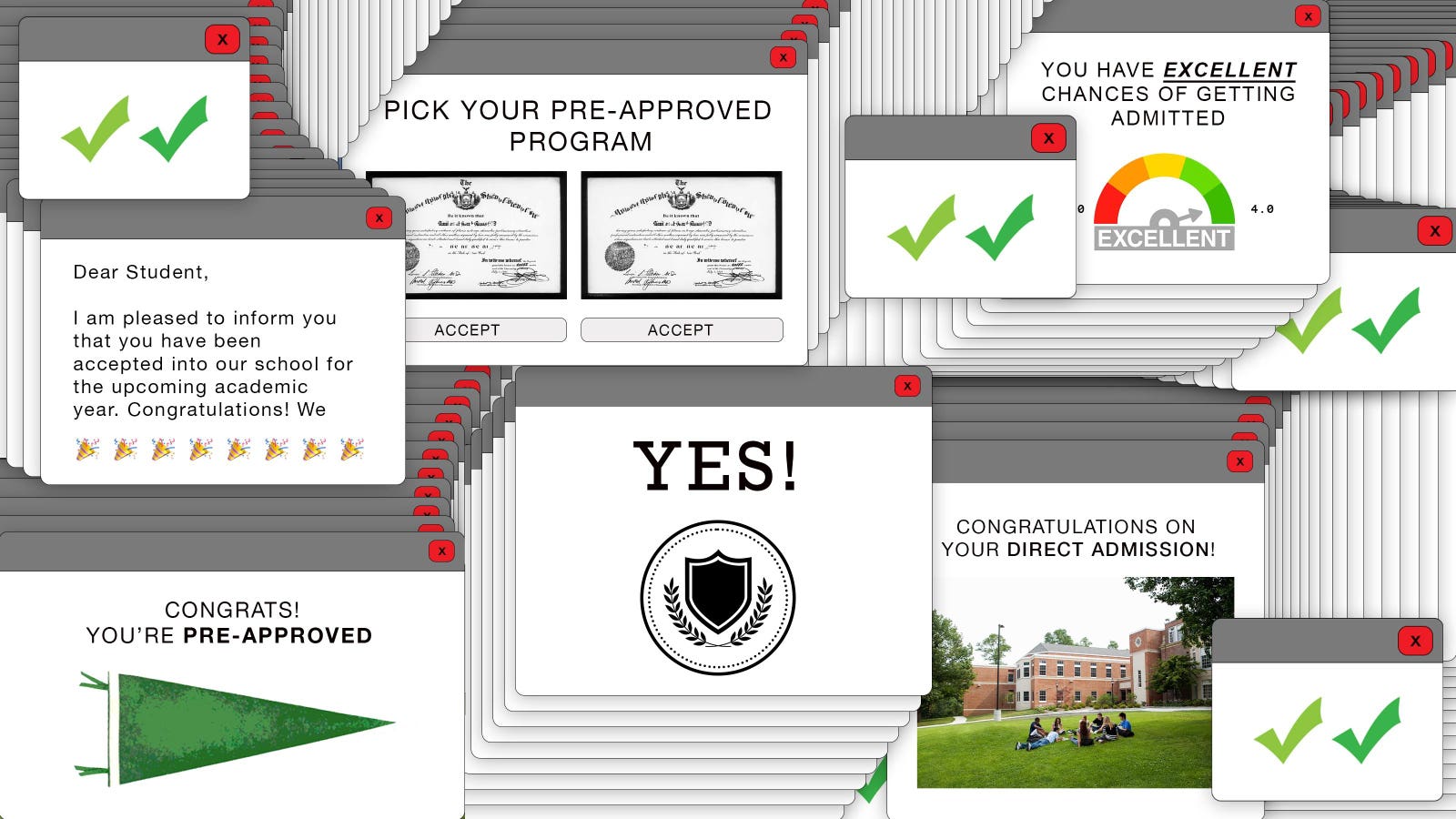Programs offering “direct admissions”—without a formal application–are spreading. The trend could accelerate in the the wake of the Supreme Court decision killing affirmative action.
By Emma Whitford, Forbes Staff
More than half of students report that applying to college is the most stressful academic experience they’ve had, but 18-year-old Elsy-Marbeli Cruz-Parra skipped the angst and the applications. By the end of October of 2022, based on her high school grades alone, she had been automatically admitted to 47 two-year or four-year colleges in Minnesota. “It was relieving,” says Cruz-Parra, the first in her family to attend college.
Cruz was one of the lucky 7,340 students tapped to participate in the first year of Minnesota’s state-run direct admissions pilot program. “Hearing from other seniors who weren’t in the direct admissions program, they were like ‘You have that? God, I have to write essays and get recommendations’ … It was just simple. I had all my top colleges already there.” She’s now a freshman at Augsburg University, nine miles from her hometown of Richfield, following a pre-med track with a major in biology. She chose Augsburg because of its small class sizes, its location (she’s commuting), and because she received a $30,000 a year scholarship to attend.
Minnesota, which this year has expanded the pilot from 39 high schools to 121 with a total of 22,764 seniors, is in the vanguard of a move towards “direct admissions” for high school students. While details vary, the core idea is this: students are offered guaranteed admission to colleges before they even apply, often based on their high school grades alone, which schools already cite as the most important factor in their decisions. Idaho and Hawaii have programs too, and other states, including Connecticut and Wisconsin, are developing them.
Meanwhile, the not-for-profit group that runs the Common Application used by hundreds of colleges, has a direct admissions pilot program for low-income and first-generation students. This admissions season it boasts 70 participating colleges, up from 14 last year. Niche, a for-profit edtech company, also offers a program (open to students at all income levels, from any state and regardless of first-generation status) that has already grown to 68 participating colleges, more than double last season’s initial roster.
The move to direct admissions is driven by evidence that students and parents, misled by coverage of the highly competitive admissions process at the Ivy League and a handful of other elite institutions—a process that favors the children of alumni and the 1%—overestimate how hard it is to get into most colleges. That creates unnecessary stress for teens and even scares some off from applying. It also pours fuel on the burgeoning unregulated college admissions consulting business. Adding to the urgency of the direct admissions movement is the Supreme Court’s decision this past June killing affirmative action for underrepresented minorities, who were already more likely to find the admissions process stressful and believe that schools might not want them.
“Data shows students and parents worry a lot about whether or not they’re going to get into college,” says Wendy Robinson, assistant commissioner for programs, policy, and grants at the Minnesota Office of Higher Education. “The truth is that most colleges accept most of their students most of the time,” she adds. “But we hear stories of the Ivies and the ultra highly selective institutions. Those stories get told over and over and over again, and it gives students and families a false perception of how hard it actually is to get into college.”
In a survey of 1,010 16- to 22-year-olds conducted for the National Association of College Admission Counseling this past February to March (in other words, before the Supreme Court decision), respondents estimated that the average acceptance rate at four-year colleges is 55%, when it’s actually 73%. Some 60% of Black and Hispanic students said the application process was the most stressful educational experience they’d ever had, compared to 42% of white students. While anxiety about the process was widespread among all segments, pessimism was greatest among those whose parents hadn’t attended college; 73% of first generation applicants thought they weren’t the type of student colleges were looking for, compared with 57% of those whose parents had attended college.
Through Minnesota’s direct admissions program, students at participating high schools are notified in the fall of their senior year when they’ve been accepted to a college based on their GPA. The state program includes 55 two-year and four-year public and private colleges in Minnesota. (Notably, the state’s flagship campus, University of Minnesota Twin Cities, ranked 69th on Forbes’ America’s Top Colleges 2023 list, does not participate.) Students are divided into six tiers based on their GPA—the lowest tier includes all students on track to graduate from high school, and the highest tier includes students with a 3.5 GPA or higher. Participating colleges choose which tiers of students to admit. Twenty-nine colleges, primarily two-year schools, admit all tiers, including the bottom one, while three colleges (Gustavus Adolphus College, the University of Minnesota Rochester and the University of St. Thomas) admit only the top tier. The state hasn’t disclosed the GPA requirements for intermediate tiers. After receiving an acceptance, students still have to complete a free application to the schools they’re interested in, which in some cases may require one of those dreaded personal essays. Plus, if students want financial aid—meaning either school discounts or federal grants or loans—their parents still need to complete the online Free Application for Federal Aid (FAFSA) form. (The FAFSA for 2024-2025 aid will be going online in December, after being significantly revised and supposedly simplified.)
In Idaho, the first state to roll out state-wide direct admissions back in 2015, all high school graduates are proactively admitted to at least six of the state’s eight public colleges, with the top students (based on their GPA through junior year) offered admission to the state flagship, the University of Idaho in Moscow, ranked 339th on Forbes’ list which ranks the 500 top colleges in the U.S. According to the University of Idaho’s website, students with unweighted cumulative GPA’s of 2.6 or better are automatically considered for admission. Admission notices are sent out by October, meaning students who are happy with their options don’t have to begin the more grueling admissions process to out-of-state and private schools.
The Common App has also geared its direct admissions pilot program to in-state schools. Low-income and first-generation applicants are offered admissions proactively, but only to colleges in their own states. The list of 70 participating schools, released today, is broad, including schools from 28 states. (See the full list below.) “Based on the results of our pilots, we already know that it’s making a positive difference,” says Jenny Rickard, president and CEO of the Common App. “Students are feeling more confident in the application process and realizing more opportunities that are available to them.”
That said, even qualified students are still largely following the traditional college application process. Of 33,000 students offered admission via Common App to one of the 14 participating colleges last year, only 800 accepted one of those offers. To get admission offers, students need to create a Common App account and fill in some basic information, including their GPAs, but they don’t need to have completed the full Common App application. Plus, a direct admission spares students from application fees and the anxiety of waiting for that first acceptance email, allowing them to winnow down the number of other applications they submit.
Niche.com, a popular college rankings and review site, has also thrown its hat into the direct admissions ring. Any student who fills out a Niche profile—it has 37 fields, including everything from basic demographic information to GPA to optional SAT scores—is automatically considered for direct admission to any of the 68 current participating colleges. On their dashboard, users see two groups of schools. The first are colleges the student has indicated interest in that have offered them a conditional acceptance based on their GPA. To receive full admission to the institution, the student must submit a full transcript, verify personal information and submit a deposit, says Luke Skurman, CEO and founder of Niche. The second group includes colleges the student hasn’t demonstrated interest in, but that would accept the student. If a user does want to receive conditional acceptance to a school in group two, all they have to do is click a button.
Already this fall, 400,000 Niche users have received direct acceptance to at least one participating college, Skurman says. He predicts that Niche will have nearly 100 colleges participating by the end of this year. Tellingly, Pittsburgh-based Niche pitches its program as a win for enrollment-hungry schools, as well as students. The 25 schools that launched before January 1—in other words in time for last year’s admissions season—got an average of 37 incremental enrollments each, Skurman claims. (The site’s business model gives students free access, while schools get free listings but pay for advertising, enhanced profiles and extra services such as direct admissions.)
Direct admissions could become even more compelling after the Supreme Court’s affirmative action decision. “If students felt that they were not what a college was looking for in general before the court ruling, it stands to reason that in a more restrictive environment, in a more discouraging environment, that students would feel even less like they’re a fit,” says David Hawkins, chief education and policy officer at NACAC. “Essentially, the Supreme Court’s decision gave a thumbs up to the status quo while scolding institutions for trying to improve diversity and equity in their admissions process … I can imagine that would be a very discouraging sort of environment for a student.”
Direct admissions could be an antidote to some of those anxieties. “This whole model is shifting the paradigm to say, ‘You know what? Actually you’re great. You’ve done the coursework that you need to in high school,’” Robinson says. “You have options and you have more options than you think that you do.”
MORE FROM FORBES
Read the full article here













Leave a Reply